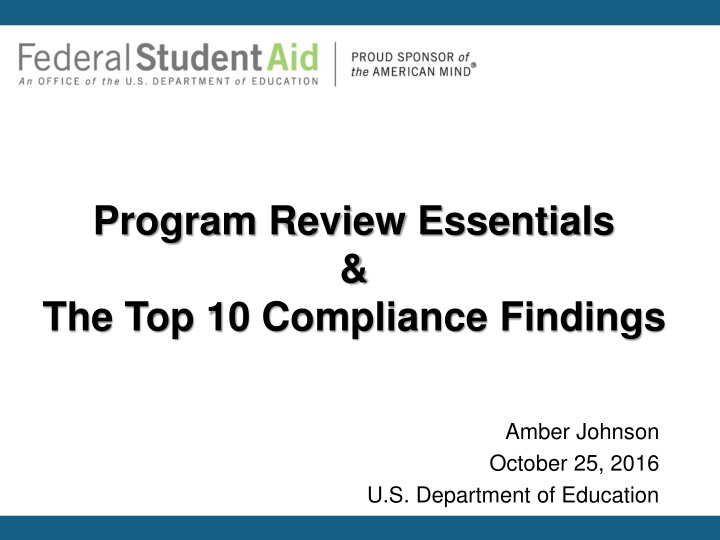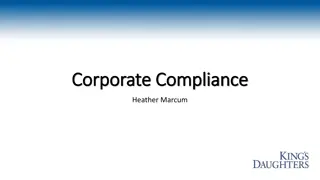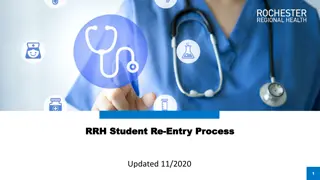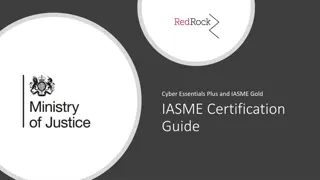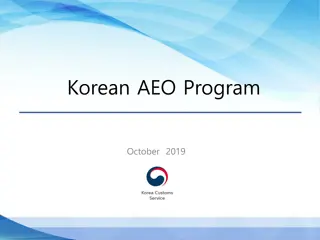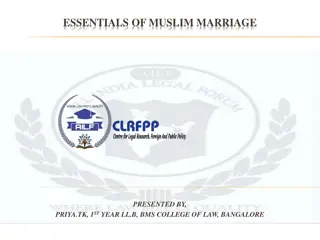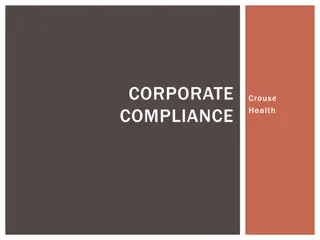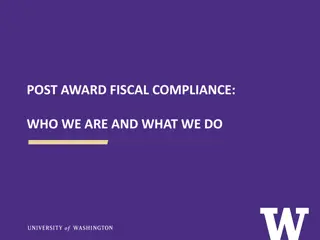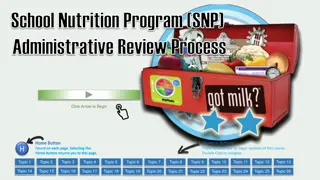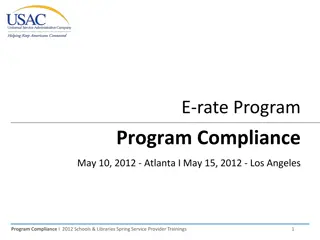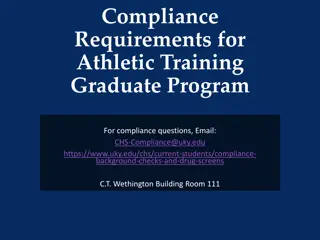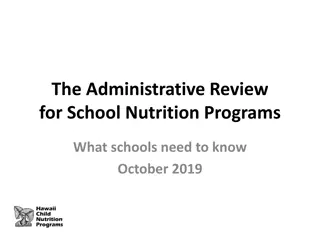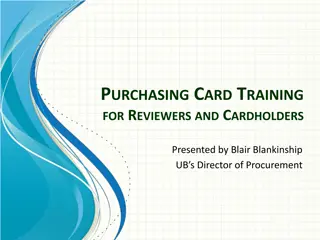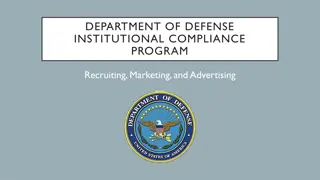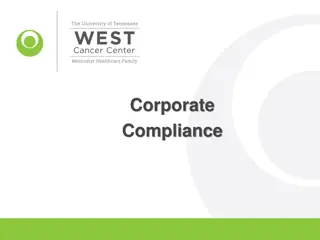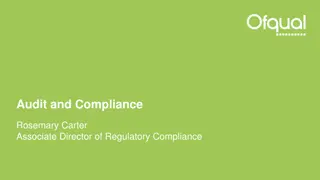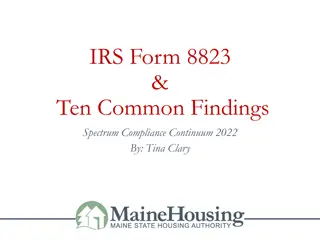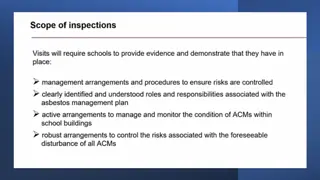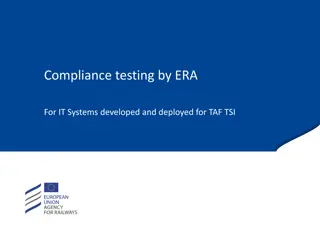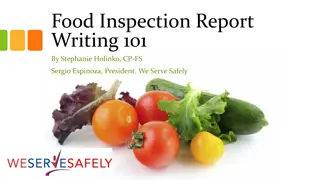Program Review Essentials & Compliance Findings Overview
This content covers essential elements of program review processes, compliance findings, institutional processes and data reviews, FSA student-level information review, and program review reporting. It includes on-site program reviews, required actions, liabilities, and more.
Download Presentation

Please find below an Image/Link to download the presentation.
The content on the website is provided AS IS for your information and personal use only. It may not be sold, licensed, or shared on other websites without obtaining consent from the author.If you encounter any issues during the download, it is possible that the publisher has removed the file from their server.
You are allowed to download the files provided on this website for personal or commercial use, subject to the condition that they are used lawfully. All files are the property of their respective owners.
The content on the website is provided AS IS for your information and personal use only. It may not be sold, licensed, or shared on other websites without obtaining consent from the author.
E N D
Presentation Transcript
Program Review Essentials & The Top 10 Compliance Findings Amber Johnson October 25, 2016 U.S. Department of Education
Program Review Process Overview Analyze school data and records to identify procedural weaknesses Examine consumer information to ensure accuracy and compliance Frame required actions and recommendations to strengthen future compliance Quantify harm and identify liabilities Refer institutions for administrative action if necessary 2
Program Review Overview Program reviews are usually conducted on-site 240 program reviews conducted nationwide in 2015-16 fiscal year For more information, see The Program Review Guide for Institutions 2009 which can be found under publications tab on IFAP http://www.ifap.ed.gov/ifap/byYear.jsp?type=programrevgui de 3
Review of Institutional Processes and Data Institutional and program eligibility Administrative capability Required policies and procedures Refund and withdrawal procedures Packaging, awarding and disbursing procedures Campus security Verification policies and procedures 4
Review of Institutional Processes and Data Fiscal records and procedures Cash management and reconciliation procedures FISAP (if applicable) Consumer information Satisfactory Academic Progress Staff/Student interviews may be conducted 5
FSA Review of Student-level Information Sample of student files reviewed Review multiple sources of student records Admission records Academic records, including current transcript Financial Aid records Student account record (ledger) Student interviews may be conducted 6
Program Review Report Preliminary report of non-compliance findings Describes required actions, including file reviews if necessary Establishes timeframe for institutional response School can request an extension List of student files reviewed attached as appendix May also include recommendations or comments 7
School Response to Program Review Report Contact reviewer with any and all questions Submit all information required in the requested format by the established deadline Complete required actions Request extension of time to respond if necessary 8
Final Program Review Determination Letter Final Program Review Determination (FPRD) will be issued after school s response is received and reviewed by the Department May require further action from the school If no further action required: Notifies the institution of the Department s final determination for each finding FPRD closes the review Includes copy of Program Review Report and school response(s) to report 9
FPRD School Action Required Contains original finding, summary of school response, Department s final determination Identifies liabilities, if any, and instructions for payment Describes appeal rights for monetary liabilities Proof of repayment of liabilities to loan holders may be required 10
Appeal of Monetary Liabilities Monetary liabilities may be appealed within 45 days Appeal filed with FSA s Administrative Actions and Appeals Services Group (AAASG) Collection of liabilities deferred for appealed amounts during the appeal process Appeal may be referred to Office of Hearings and Appeals (OHA) for review by an Administrative Law Judge Either party can appeal OHA decision to the Secretary of Education within 30 days 11
Expedited Determination Letter (EDL) Serves as both preliminary report and final determination letter School is not required to respond Usage limited No findings, or only minor and non-systematic findings Any identified findings corrected prior to EDL issuance Any liabilities identified were paid/collected prior to issuance of EDL 12
Top 10 Program Review Findings 1. Crime Awareness Requirements Not Met 2. Verification Violations 3. Return to Title IV (R2T4) Calculation Errors 4. Student Credit Balance Deficiencies 5. Drug Abuse Prevention Program Requirements Not Met 13
Top 10 Program Review Findings 6. Student Status Inaccurate/Untimely Reporting 7. Entrance/Exit Counseling Deficiencies 8. Consumer Information Requirements Not Met 9. SAP Policy Not Adequately Developed/Monitored 10. Inaccurate Recordkeeping 14
Top 10 Audit Findings 1. Repeat Finding Failure to Take Corrective Action 2. Student Status Inaccurate/Untimely Reporting 3. R2T4 Calculation Errors 4. R2T4 Funds Made Late 5. Verification Violations 15
Top 10 Audit Findings 6. Pell Overpayment/Underpayment 7. Qualified Auditor s Opinion Cited in Audit 8. Entrance/Exit Counseling Deficiencies 9. Student Credit Balance Deficiencies 10. Improper Origination of DL 16
Reasons for Institutional Self-Evaluation Assessment of staff training needs Quality control Test automated systems Ensure compliance Preparation for audit or program review Reduce potential liabilities Demonstrate administrative capability Self-disclosure of compliance issues is encouraged 17
Self-Evaluation Tools FSA Assessments http://www.ifap.ed.gov/qahome/fsaassessment.html Develop/Update policies and procedures Self-assess with file review worksheets Peer review State and national associations Independent financial aid management consultant Internal review Internal peer review/cross-training 18
Top 10 Clery Mistakes 1. Failure to properly report crimes based on geography 2. Improper classification and under-reporting of crimes 3. Lack of adequate policy statements 4. Failure to publish and distribute the annual security report as a comprehensive document 5. Inadequate systems for collecting statistics from required sources 20
Top 10 Clery Mistakes 6. Incorrect reporting of referrals for disciplinary action for liquor law and drug violations 7. Inaccurate reporting of crime statistics to the Department 8. Deficient crime log 9. Inaccurate reporting of hate crimes 10. Failure to develop, implement and adhere to established policy 21
Campus Security Information Resources OPE Campus Security webpage (http://www2.ed.gov/admins/lead/safety/campus.html) Handbook for Campus Crime Reporting (http://rems.ed.gov/docs/ED_CampusSafetyAndSecurityReportingHa ndbook.pdf) Online tutorial for use after reading Handbook Variety of other resources: Statute Regulations Statistics FSA Assessments: Consumer Information (http://www.ifap.ed.gov/qahome/qaassessments/consumerinfor mation.html) 22
Resolving Verification Findings Develop internal checklist Update policies and procedures and ensure they are implemented Monitor processing of ISIR corrections and verification status codes Perform monthly file reviews and/or develop quality control review process 23
Causes of R2T4 Findings Late refunds School policies and procedures not followed Inadequate system in place to identify/track unofficial withdrawals No system in place to track number of days remaining to return funds Regulation 668.22(j)(1) requires return of funds as soon as possible but no later than 45 days after the date of determination 24
Causes of R2T4 Findings R2T4 calculation errors Incorrect number of days used in term (vacations) Actual clock hours used instead of scheduled hours Incorrect aid used as aid that could have been disbursed Incorrect amounts used for institutional charges Mathematical and/or rounding errors 25
Resolving R2T4 Findings Develop and implement system to track and monitor deadlines Use R2T4 on the Web for calculations Can set up term calendar profiles Make sure you have accurate information about scheduled breaks of five or more consecutive days Use accurate information for scheduled hours for each day for clock hour programs (and document it) Implement peer review of calculation Perform monthly self-assessment 26
Student Credit Balance Deficiency Causes Credit balances not released within 14 days Non-compliant authorization to retain Title IV credit balances Inadequate process in place to determine when Title IV credit balance exists Credit balances not released by end of loan period or award year Failure to maintain required credit balance ledger 27
Causes of Enrollment Status Findings Roster file not timely submitted to NSLDS Untimely reporting of specific student information Conflicting enrollment status dates and types (G vs. W) Failure to report enrollment status changes to less than half-time Failure to report accurate enrollment types and effective dates 28
Resolving Enrollment Status Findings Implement process to track and monitor enrollment status changes Maintain accurate enrollment records Train staff on requirements, including definitions of different status codes Ensure effective communication among all staff and offices with enrollment reporting responsibilities 29
Resolving Exit Counseling Deficiencies Exit counseling not conducted/documented for withdrawn students or graduates Upload results of counseling conducted outside of Studentloans.gov to NSLDS Exit counseling materials not sent to students who failed to complete online counseling Maintain copy of cover letter or e-mail to non-school address for sent materials 30
Causes of SAP Deficiencies Policy does not contain all required components Does not address effects of remedial courses, course incompletes, withdrawals, changes of major or program, and/or transfer credits Improper use of financial aid Warning, Appeals, Probation and Academic Plans in SAP policy Insufficient documentation for appeals Failure to consistently apply policy Aid disbursed to students not making progress 34
Inaccurate Recordkeeping Examples Conflicting last dates of attendance (LDAs) Inadequate or mismatched attendance records for schools required to take attendance Disbursement dates reported to COD do not match date of actual disbursements to student account Failure to determine unofficial withdrawals Academic records do not support disbursements Lack of documentation for COA adjustments Inadequate leave of absence (LOA) documentation 35
Accounting Records Deficiencies Example Failure to clearly show Title IV disbursements on individual student account records Disbursement dates reported to COD do not match actual date of disbursement to student accounts Failure to reconcile school records with G5 and COD (and FISAP, if applicable) No method to track Title IV credit balances due to failure to maintain running balance on student accounts 36
Inconsistent/Missing Information Causes No system in place to coordinate information collected in different offices Insufficient or missing documentation to support professional judgment or dependency override Solutions File/Scan documents timely Keep organized and consistent files Ensure all documents are received and reviewed Establish procedures to communicate information with other offices 37
Repeat Audit Findings Causes: Failure to implement Corrective Action Plan (CAP) CAP did not remedy the compliance problem Ineffective CAP from previous year used again Internal controls not established to ensure CAP is successfully implemented Solutions: Periodically review results of CAP to ensure it is working as intended Revise CAP as necessary 38
Causes of Pell Over- and Underpayments Clock hour programs Incorrect proration for weeks or hours Incorrect handling of crossover payment periods Credit hour programs Failure to follow census date policy Failure to adjust for enrollment status changes between terms Failure to document student established attendance 39
Regional Contacts Philadelphia School Participation Team Main Number 215-656-6442 Joe Kern (IIS) Joe.Kern@ed.gov; 215-656-8566 Philadelphia Training Officers Amber Johnson Amber.Johnson@ed.gov; 202-377-3369 Craig Rorie Craig.Rorie@ed.gov; 215-656-5916 41
Training Feedback To ensure quality training, we ask all participants to please fill out an online session evaluation. Go to https://www.surveymonkey.com/s/AmberJohnson Evaluation form is specific to Amber Johnson Additional feedback about training can be directed to JoAnn.Borel@ed.gov; 409-579-3776 42
Thank You! 43
